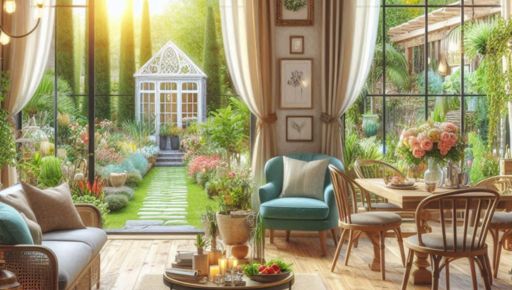Creating a home garden is an enjoyable and rewarding experience that allows you to transform your outdoor space into a peaceful retreat. Whether you’re a seasoned gardener or a beginner, starting a home garden can be a fulfilling way to connect with nature while enhancing the beauty of your property. In this comprehensive guide, we’ll walk you through essential tips, creative ideas, and practical advice to help you design and maintain the perfect home garden.
Why Create a Home Garden?
A home garden offers numerous benefits that go beyond aesthetics. It can improve your well-being, enhance the environment, and even provide fresh, homegrown produce. Let’s explore some of the key reasons why having a home garden is a great idea:
- Mental Health Benefits: Gardening has been shown to reduce stress and anxiety while promoting relaxation and mindfulness. The act of nurturing plants can be a form of therapy, offering a sense of accomplishment and calm.
- Increased Property Value: A well-designed garden can increase the overall value of your home. Potential buyers often appreciate a beautiful and well-maintained outdoor space, making it an excellent investment.
- Sustainability: A garden can help you live more sustainably by reducing your carbon footprint. Growing your own fruits and vegetables can reduce your reliance on store-bought products and packaging, while plants also absorb carbon dioxide and release oxygen into the atmosphere.
Planning Your Home Garden
Before you start planting, it’s important to plan your garden carefully. Proper planning ensures that your home garden will flourish and fit your needs and lifestyle. Here are some essential steps for planning:
- Assess Your Space: The first step in creating a home garden is evaluating your outdoor space. Look at the amount of sunlight your garden receives, the type of soil, and any existing structures that may affect your garden’s design. Some plants thrive in full sun, while others prefer shade, so understanding your space is key to success.
- Set a Budget: Depending on the size and scale of your garden, creating a home garden can range from a small project to a major landscaping endeavor. Establish a budget that includes the costs of tools, plants, soil, and any other materials you may need. This will help you stay on track financially.
- Choose Your Garden Style: There are countless garden styles to choose from. Whether you prefer a formal, structured garden or a more relaxed, cottage-style garden, your choice will influence the types of plants and garden features you incorporate. Some popular garden styles include:
- Contemporary Gardens: Focus on clean lines, minimalistic design, and modern materials such as concrete and metal.
- Cottage Gardens: Feature a mix of colorful flowers, herbs, and vegetables, often with rustic charm and whimsical touches.
- Japanese Gardens: Emphasize simplicity, tranquility, and natural materials like stones, bamboo, and water elements.
- Vegetable Gardens: For those who enjoy homegrown produce, a vegetable garden is an excellent choice. It’s both functional and rewarding, providing fresh ingredients for your meals.
Essential Elements of a Home Garden
Every successful garden requires key elements to thrive. Below are some of the basics to include in your home garden:
- Soil Preparation: Healthy soil is the foundation of a thriving garden. Test your soil to determine its pH and nutrient levels, and amend it with compost or organic matter to improve fertility. If you’re planting in containers, choose high-quality potting mix for optimal growth.
- Watering System: Plants need water to grow, but it’s important to avoid overwatering. Depending on your climate, consider installing an irrigation system like a drip irrigation system or a soaker hose to ensure consistent watering without wasting water.
- Lighting: Sunlight is crucial for plant growth, but the amount of light varies based on the plants you choose. Ensure that your garden receives the appropriate amount of sunlight by strategically placing plants in areas with varying levels of sun exposure. Shade-loving plants should be placed in areas with less direct sunlight, while sun-loving plants need more exposure.
- Mulch: Applying mulch around your plants helps retain moisture, suppress weeds, and regulate soil temperature. Organic mulches such as bark, straw, or leaves are excellent options.
Choosing Plants for Your Home Garden
Selecting the right plants for your home garden is essential for its success. Here are some tips to help you choose plants that will thrive in your environment:
- Consider Your Climate: The local climate plays a significant role in plant selection. Research plants that are well-suited to your region’s temperature, rainfall, and soil conditions. Native plants are often a great choice because they are adapted to local conditions and require less maintenance.
- Mix of Flowers, Shrubs, and Trees: A diverse garden with a mix of flowers, shrubs, and trees can create visual interest and provide year-round beauty. Flowers add color and fragrance, shrubs offer structure, and trees provide shade and height.
- Edible Plants: Incorporating edible plants into your garden is a great way to enjoy fresh produce. Consider growing herbs like basil, mint, and rosemary, as well as vegetables such as tomatoes, cucumbers, and peppers. Not only will you have access to healthy food, but it can also save you money on groceries.
- Seasonal Plants: Choose plants that bloom in different seasons to ensure that your garden looks beautiful year-round. Early spring flowers, summer blooms, fall foliage, and winter evergreens will keep your garden looking vibrant no matter the time of year.
Creating Outdoor Features
In addition to plants, outdoor features can elevate your home garden, making it a space for relaxation, entertainment, and enjoyment. Here are some popular outdoor features to consider:
- Paths and Walkways: Create paths using natural materials such as gravel, wood, or stone to guide visitors through your garden. Well-designed walkways not only add visual appeal but also make it easier to navigate your garden.
- Water Features: Adding a water feature like a fountain, pond, or small waterfall can create a serene atmosphere. The sound of flowing water can be soothing and adds an element of tranquility to your garden.
- Seating Areas: Create comfortable seating areas where you can relax and enjoy your garden. Consider benches, chairs, or even a hammock to provide a spot for quiet reflection or socializing with friends and family.
- Lighting: Outdoor lighting can extend the enjoyment of your garden into the evening. Use solar-powered lights, string lights, or lanterns to highlight key areas, create ambiance, and make your garden safe to navigate at night.
Maintaining Your Home Garden
Once your home garden is established, it’s important to maintain it properly to keep it healthy and thriving. Regular care includes watering, pruning, and managing pests. Here are some maintenance tips:
- Watering: Water your garden regularly, but avoid overwatering. Check the soil moisture before watering and adjust your watering schedule based on the season.
- Pruning and Deadheading: Prune dead or damaged branches to encourage new growth and maintain the shape of your plants. Deadheading spent flowers will promote continuous blooming in many flowering plants.
- Pest Control: Keep an eye out for pests that could damage your plants. Consider using natural pest control methods such as neem oil or introducing beneficial insects like ladybugs to manage common garden pests.
- Fertilizing: Fertilize your plants periodically to provide the nutrients they need to grow strong and healthy. Use organic fertilizers or compost for the best results.
Conclusion
A home garden is an investment that pays off in both beauty and functionality. By carefully planning, selecting the right plants, and maintaining your garden, you can create a peaceful retreat right outside your door. Whether you’re looking to grow your own food, enhance your outdoor living space, or simply enjoy the joy of gardening, a home garden is an opportunity to connect with nature and create something truly special. Happy gardening!

